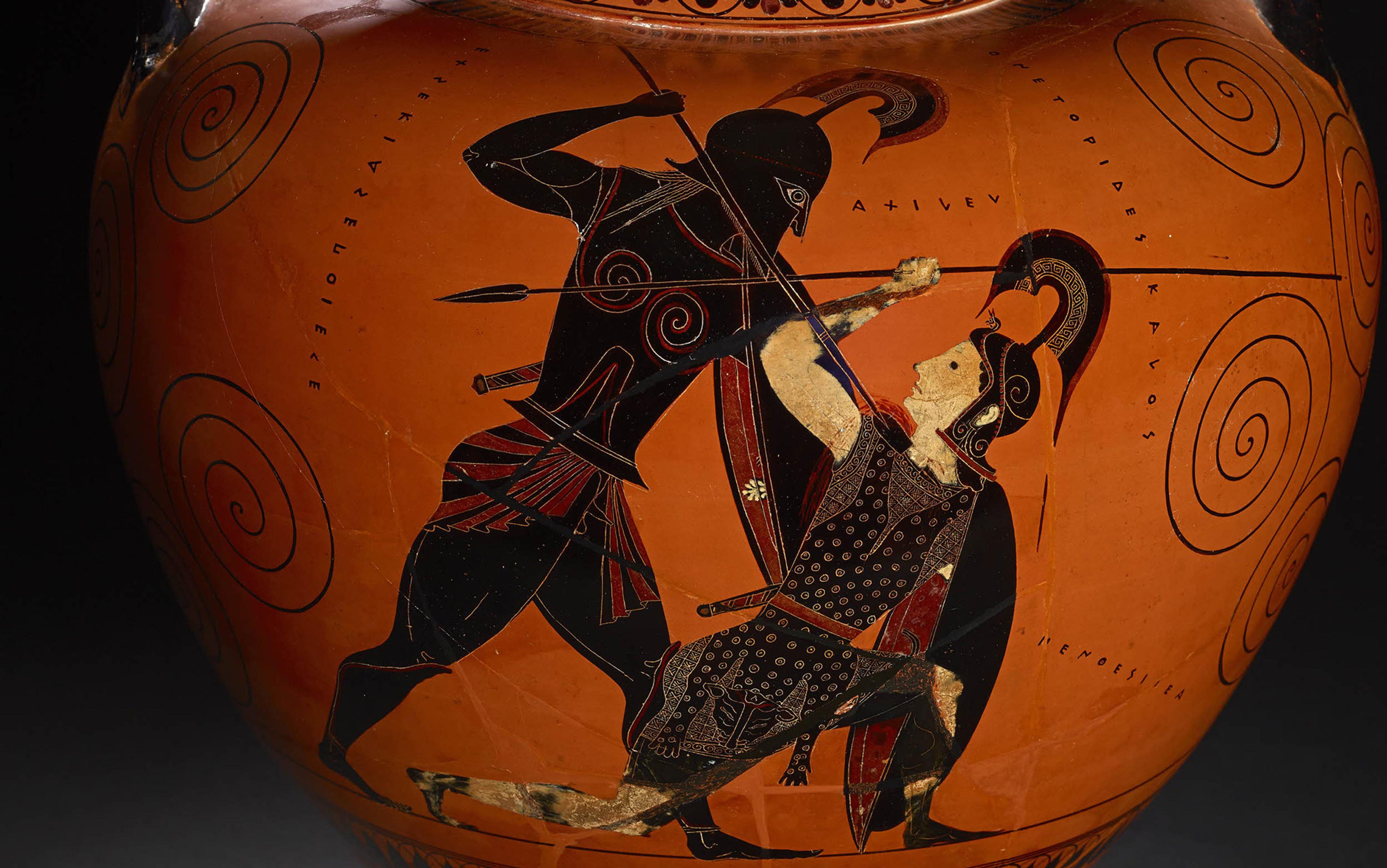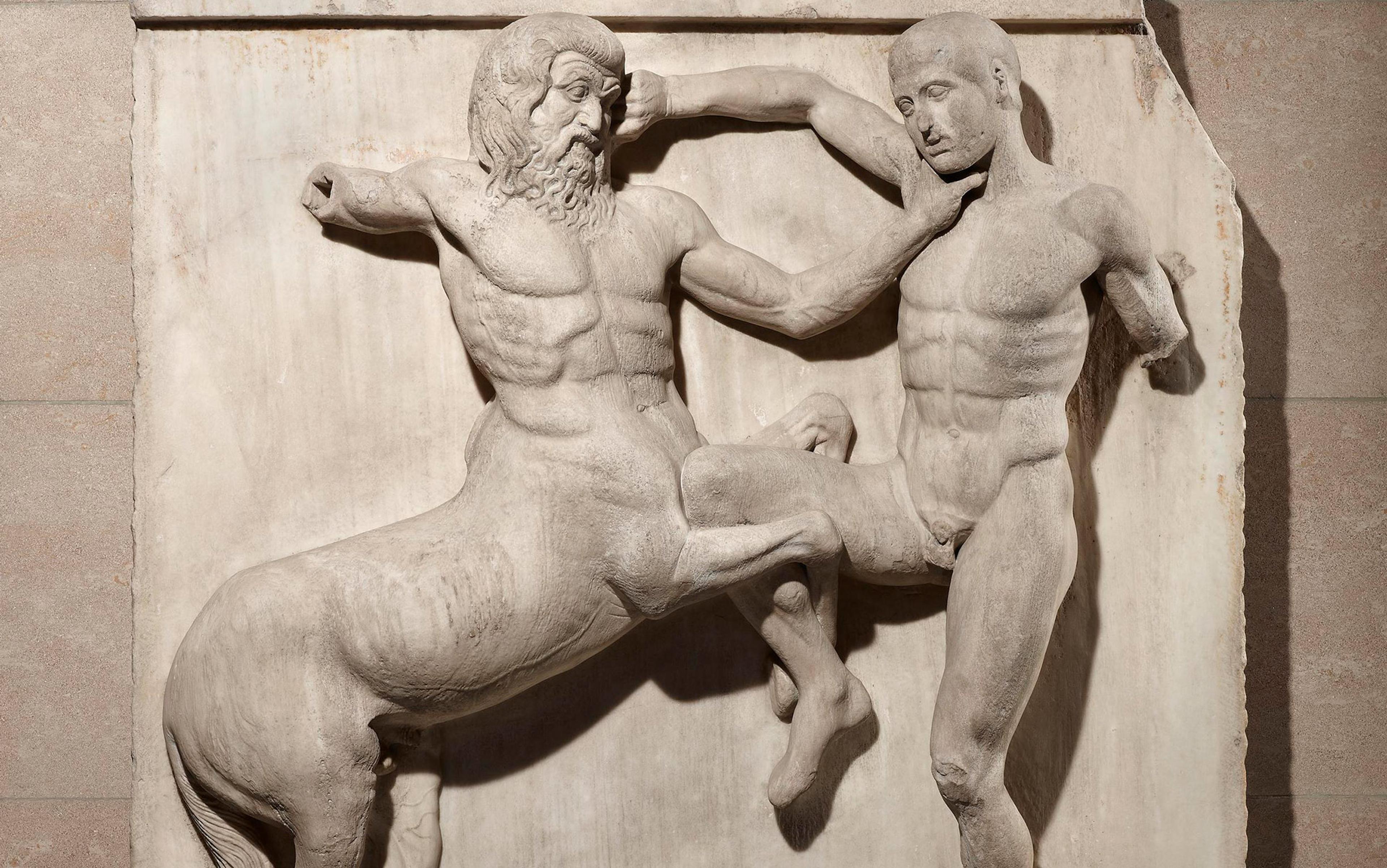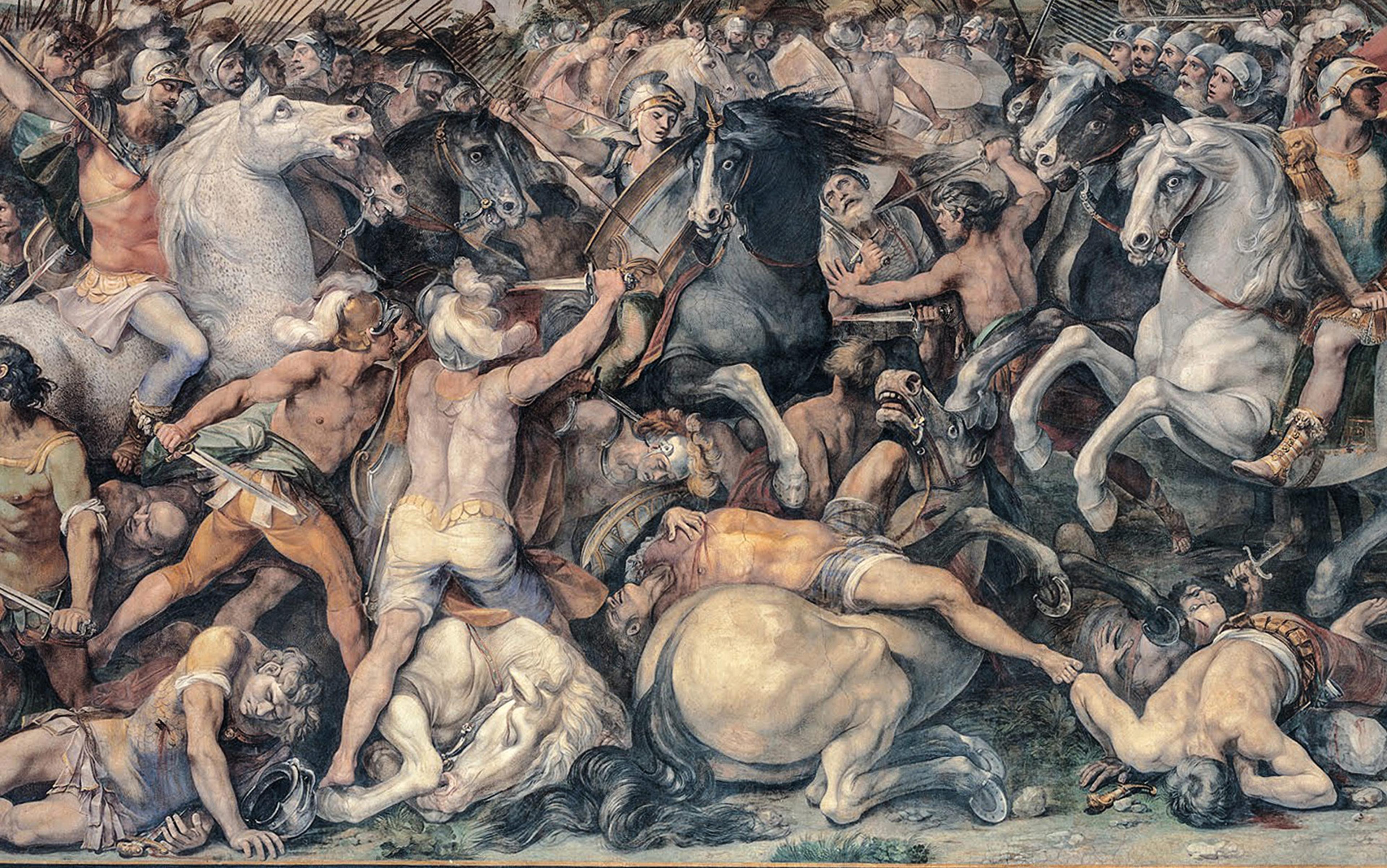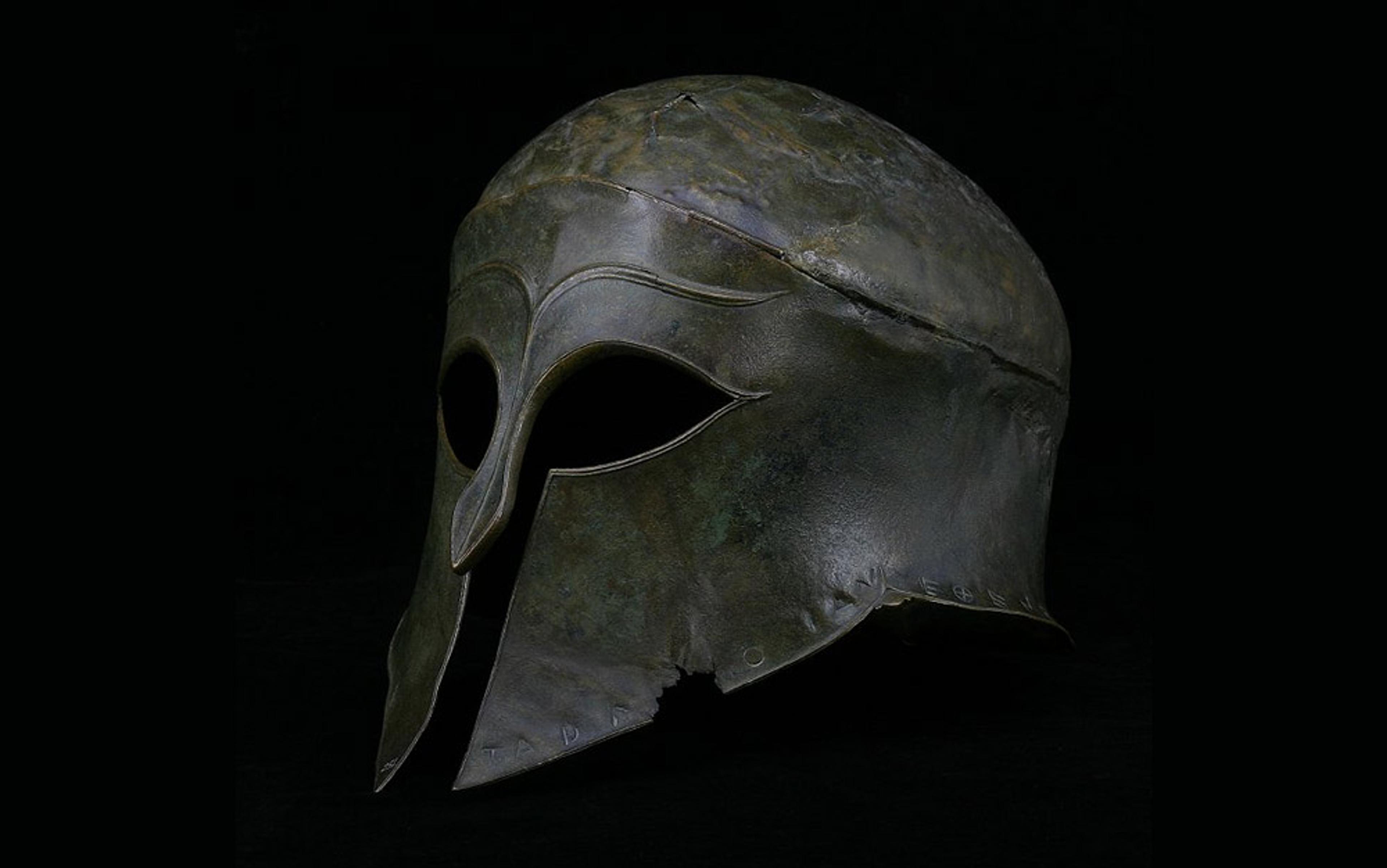Few issues provoke such controversy as the skin-colour of the Ancient Greeks. Last year in an article published in Forbes, the Classics scholar Sarah Bond at the University of Iowa caused a storm by pointing out that many of the Greek statues that seem white to us now were in antiquity painted in colour. This is an uncontroversial position, and demonstrably correct, but Bond received a shower of online abuse for daring to suggest that the reason why some like to think of their Greek statues as marble-white might just have something to do with their politics. This year, it was the turn of BBC’s new television series Troy: Fall of a City (2018-) to attract ire, which cast black actors in the roles of Achilles, Patroclus, Zeus, Aeneas and others (as if using anglophone northern European actors were any less anachronistic).
The idea of the Greeks as paragons of whiteness is deeply rooted in Western society. As Donna Zuckerberg shows in her book Not All Dead White Men (2018), this agenda has been promoted with gusto by sections of the alt-Right who see themselves as heirs to (a supposed) European warrior masculinity. Racism is emotional, not rational; I don’t want to dignify online armies of anonymous trolls by responding in detail to their assertions. My aim in this essay, rather, is to consider how the Greeks themselves viewed differences in skin colour. The differences are instructive – and, indeed, clearly point up the oddity of the modern, western obsession with classification by pigmentation.
Homer’s Iliad (a ‘poem about Ilion, or Troy’) and Odyssey (a ‘poem about Odysseus’) are the earliest surviving literary texts composed in Greek. For most other Greek literature, we have a more or less secure understanding of who the author was, but ‘Homer’ is still a mystery to us, as he was to most Ancient Greeks: there is still no agreement whether his poems are the works of a single author or a collective tradition.
The poems are rooted in ancient stories transmitted orally, but the decisive moment in stabilising them in their current form was the period from the 8th to the 7th centuries BCE. The siege of Troy, the central event in the mythical cycle to which the Homeric poems belong, might or might not be based on a real event that took place in the earlier Bronze Age, in the 13th or 12th century BCE. Historically speaking, the poems are an amalgam of different temporal layers: some elements are drawn from the contemporary world of the 8th century BCE, some are genuine memories of Bronze Age times, and some (like Achilles’ phrase ‘immortal glory’) are rooted in seriously ancient Indo-European poetics. There is a healthy dollop of fantasy too, as all Greeks recognised: no one ever believed, for example, that Achilles’ horses really could talk.
Achilles was not a historical personage; or, rather, the figure in the poem might or might not be distantly connected to a real figure, but that isn’t the point. Achilles, as we have him and as the Greeks had him, is a mythical figure and a poetic creation. So the question is not ‘What did Achilles look like?’ but ‘How does Homer portray him?’ We have only one thing to go on here: Achilles is said in the Iliad to have xanthos hair. This word is often translated as ‘blond’, a translation that gives a powerful steer to the modern imagination. But translation can be deceptive. As Maria Michel Sassi’s essay for Aeon makes clear, the Greek colour vocabulary simply doesn’t map directly onto that of modern English. Xanthos could be used for things that we would call ‘brown’, ‘ruddy’, ‘yellow’ or ‘golden’.
Behind this apparently simple question – how do we translate a single word from Greek into English – lies a huge debate, both philosophical and physiological, that has exercised scholars for more than a century: do different cultures perceive and articulate colours in different ways? This isn’t a question we can address here, but it’s important to stress that early Greek colour terms have been at the heart of these debates (ever since the British prime minister William Gladstone, a keen amateur classicist, weighed in during the late-19th century).
The early Greek vocabulary of colour was very strange indeed, to modern eyes. The word argos, for example, is used for things that we would call white, but also for lightning and for fast-moving dogs. It seems to refer not simply to colour, but also to a kind of flashing speed. Khlōros (as in the English ‘chlorophyll’) is used for green vegetation, but also for sand on a shore, for tears and blood, and for the pallor of skin of the terrified. One scholar describes it as capturing the ‘fecund vitality of moist, growing things’: greenish, certainly, but colour represents only one aspect of the word, and it can easily be overridden.
Weirdly, some early Greek terms for colour seem also to indicate intense movement. The same scholar points out that xanthos is etymologically connected to another word, xouthos, which indicates a rapid, vibrating movement. So, while xanthos certainly suggests hair in the ‘brown-to-fair’ range, the adjective also captures Achilles’ famous swift-footedness, and indeed his emotional volatility.
To call Odysseus ‘black-skinned’ associates him with the rugged, outdoors life he lived on ‘rocky Ithaca’
Let’s take another example, which will come as a surprise to those whose mental image of Homeric Greeks is marble-white. In the Odyssey, Athena is said to enhance Odysseus’ appearance magically: ‘He became black-skinned (melagkhroiēs) again, and the hairs became blue (kuaneai) around his chin.’ On two other occasions when she beautifies him, she is said to make his hair ‘woolly, similar in colour to the hyacinth flower’. Now, translating kuaneos (the root of the English ‘cyan’) as ‘blue’, as I have done here, is at first sight a bit silly: most translators take the word to mean ‘dark’. But given the usual colour of hyacinths, maybe – just maybe – he did have blue hair after all? Who knows; but here, certainly, is another example of just how alien the Homeric colour scheme is. To make matters worse, at one earlier point in the poem his hair is said to be xanthos, ie just like Achilles’; commentators sometimes take that to refer to grey grizzle (which is more evidence that xanthos doesn’t straightforwardly mean ‘blond’).
And what of ‘black-skinned’? Was Odysseus in fact black? Or was he (as Emily Wilson’s acclaimed new translation renders it) ‘tanned’? Once again, we can see how different translations prompt modern readers to envisage these characters in completely different ways. But to understand the Homeric text, we need to shed these modern associations. Odysseus’ blackness, like Achilles’ xanthos hair, isn’t intended to play to modern racial categories; rather, it carries with it ancient poetic associations. At another point in the Odyssey, we are told of Odysseus’ favourite companion Eurybates, who ‘was round-shouldered, black-skinned (melanokhroos), and curly-haired … Odysseus honoured him above his other comrades, because their minds worked in the same way.’ The last part is the crucial bit: their minds work in the same way, presumably, because Eurybates and Odysseus are both wily tricksters. And, indeed, we find the association between blackness and tricksiness elsewhere in early Greek thought.
‘Black’ (melas) and ‘white’ (leukos) are also – importantly – gendered terms: females are praised for being ‘white-armed’, but men never are. This differentiation finds its way into the conventions of Greek (and indeed Egyptian) art too, where we find women often depicted as much lighter of skin than men. To call a Greek man ‘white’ was to call him ‘effeminate’. Conversely, to call Odysseus ‘black-skinned’ might well associate him with the rugged, outdoors life he lived on ‘rocky Ithaca’.
So to ask whether Achilles and Odysseus are white or black is at one level to misread Homer. His colour terms aren’t designed to put people into racial categories, but to contribute to the characterisation of the individuals, using subtle poetic associations that evaporate if we just plump for ‘blond’ rather than ‘brown’, ‘tanned’ rather than ‘black’ (and vice versa). Greeks simply didn’t think of the world as starkly divided along racial lines into black and white: that’s a strange aberration of the modern, Western world, a product of many different historical forces, but in particular the transatlantic slave trade and the cruder aspects of 19th-century racial theory. No one in Greece or Rome ever speaks of a white or a black genos (‘descent group’). Greeks certainly noticed different shades of pigmentation (of course), and they differentiated themselves from the darker peoples of Africa and India, sometimes in aggressively dismissive terms that we would now call racist; but they also differentiated themselves from the paler peoples of the North (see Hippocrates’ On Airs, Waters, and Places). Greeks did not, by and large, think of themselves as ‘white’.
Xenophon in his Anabasis, the account of a mercenary army’s retreat through what is now central Turkey, describes meeting a curious people who asked if they could have public intercourse with the women accompanying the Greek army. This wasn’t the most peculiar thing about them: ‘all of them were white, the men and the women alike’. Being white, particularly for men, was in Xenophon’s eyes a sign of this people’s alienness.
We might add that modern geneticists too find classification by skin colour unhelpful, and indeed avoid the term ‘race’ (a meaningless category in biological terms). There is relatively little genetic difference between the human populations of different continents, and levels of skin pigmentation are a very poor proxy for general genetic relatedness. The distinction between ‘black’ African and ‘white’ European peoples, then, is not just unGreek: it’s also unbiological.
But this, of course, isn’t the only way of looking at the question. Let’s ask a different question: did the Homeric poems know of people whom we would describe as black Africans? Did they imagine them at Troy? Let’s remember that there was no defined territory of ‘Greece’ at this time (ie, around the 8th century BCE): Greek-speakers were founding colonies all over the Mediterranean, including in north Africa and on the Nile Delta. Trade with Egypt led the Greeks to borrow what we think of now as definitively Greek cultural forms, such as monumental temple architecture and the statues of standing males known as kouroi. The sea voyages of Odysseus described in the Odyssey capture the adventurous spirit of that age, and indeed voyages to Egypt are mentioned on a couple of occasions (though Homeric geography isn’t always precise). Egypt, of course, was a massively rich and impressively ancient state, and exerted a strong imaginative and real pull on Greeks throughout the ages.
In the upper (ie, southern) part of the Nile valley, in modern Sudan, lay another magnificent civilisation known variously as Kush, the Meroitic kingdom and Nubia. The Greeks came to call this place ‘Ethiopia’, which can mean ‘land of the burnt-faced people’. Ethiopians are mentioned several times in the Homeric poems as a pious, just people favoured by the gods, who visit them to share meals in a distant place ‘between the sunset and the dawn’. In the Odyssey, Menelaus claims to have visited them. Unfortunately, there is no description of what these people looked like and, given that they are said to live in the far East and far West, near the ocean, it might be that they had nothing at all to do with Africa (although it could be that he thought of Africa as lying in the West: the Homeric sense of geography, especially of remote lands, is very sketchy indeed). Post-Homeric mentions of the Ethiopians, however, place them firmly in Africa, and usually in the region of modern Sudan. The philosopher Xenophanes in the 6th century, for example, refers to them as ‘flat-nosed and black’.
Early vase paintings are difficult to use as evidence, as all the figures are black, regardless of ethnicity
Why is this relevant to Homer? Because the Iliad and the Odyssey formed part of a mythical sequence that include Arctinus’ Aethiopis, ‘the poem about the Ethiopian’, which picked up the story where the Iliad left off, ie immediately after the burial of the top Trojan, Hector. The Trojans, having lost their best warrior, immediately bring in reinforcements from far-off lands: first, Penthesilea and the Amazons, and then Memnon and the Ethiopians. Both of these are major, heroic figures, who are defeated by Achilles; Memnon is given immortality after his death. So, the crucial question now is: were Memnon and his men imagined to be black?
Again, the tale is a tangled one. The Aethiopis doesn’t survive, and although we have a summary by a later writer, it tells us nothing about the ethnicity of the Ethiopians. For what it’s worth, a much later poetic recreation of the story told by an epic poet of the Roman Empire, Quintus of Smyrna (3rd century CE) – usually thought to be a traditionalist, and perhaps following Arctinus here – has the Ethiopians at Troy as black. But in the early period, the picture is confused. Early vase paintings are difficult to use as evidence, because all of the figures are black, regardless of ethnicity (due to the so-called ‘black-figure’ technique that the painters used). In one case from the sixth century BCE, we find a heavily armed (and therefore invisible to the viewer’s eye) Memnon flanked by two evidently African ‘squires’. When red-figure painting comes in, around 530 BCE in Athens, we find a couple of vase paintings that present Memnon as identical in colouring to the Greeks. But there are also vases that show mythical combatants with (exaggerated) African features, who might or might not be Memnon and his warriors. It is hard to think who else they might be; and even if they are not exactly Memnon, they are evidence that the Greeks could imagine African men in scenes of mythical combat.
In the 5th century we begin to get more detailed accounts in literary sources. Some depict Memnon as a Persian – perhaps reflecting the influence of the Persian Wars, which took place in the period from 490-472 BCE. But we do find African Memnon, too: a fragment of Aeschylus, probably from his play Memnon, reads: ‘I have learned definitely, and know, that I can speak of his [Memnon’s] origin as being from the land of Ethiopia, from which the seven-mouthed Nile rolls down its fertilising stream in overflowing abundance.’ The phrasing suggests that the speaker knows he is contradicting an alternative tradition about Memnon’s origin (probably the Persian one).
So, in sum: we just don’t know whether Homer or Arctinus imagined African warriors at Troy, but there were certainly slightly later Greeks who did. My hunch is that Arctinus’ Ethiopians were black Africans (though Memnon himself might not have been): certainly there must have been some reason why the Homeric vagueness about the location of Ethiopia was so rapidly replaced by certainty that it lay in Africa, and a major epic poem is exactly the kind of thing that could have provided such authoritative certainty.
The presence, in at least some early Greeks’ minds, of black Africans on the battlefield at Troy, however, might be thought sharply to reduce the possibility that the Greek forces themselves included warriors whom we would call black today. The big question, of course, is whether we can say anything about what Greeks themselves looked like. Here we have to tread especially carefully, because there are a lot of traps. People often and very easily refer to Ancient Greeks as ‘European’, as if the meaning of that term were self-evident. But ‘Europe’ is a historical construct, not a fact of nature. Yes, Greek as a language belongs to the Indo-European family linking Irish in the West to Sanskrit in India, via Armenian, Persian and many other languages, but let’s not get misled by the word ‘European’ in that phrase: it doesn’t in itself mean that speakers of a given language within the family are automatically European, any more than the ‘Indo-’ part means that they are Indian.
The settlers on the Greek peninsula migrated from the East. Culturally speaking, early Greek culture was defined by sea travel, and most of their dealings were with the coastal peoples of the eastern Mediterranean. Their most significant interactions in the early phase that we are discussing were with Semitic peoples (Phoenicians and Babylonians) and Egyptians. Early Greeks had little or no knowledge of, or interest in, most of what is now thought of as ‘Europe’: the inland and non-Mediterranean regions to the north-west. This is not, of course, directly relevant to the question of what Greeks actually looked like; but it’s a reminder that ‘European’ is a pretty meaningless term for ancient history, and is likely to mislead us.
Any attempt to answer the question of what Ancient Greeks looked like has to be led by genetic research, not by assumptions. A paper published last year in the journal Nature analysed the DNA of 19 individuals from mainland Greece and Crete. The original owners of the DNA lived well before the period we are considering, between c2900 BCE-c1200 BCE. The results of the analysis, however, are relevant to the later era, too. It showed that there was a broad genetic continuity between Greeks of the Minoan period (taken in the study as c2900-1700 BCE) and Greeks of the present day. To quote the paper, Minoan Greeks took ‘at least three-quarters of their ancestry from the first Neolithic farmers of western Anatolia and the Aegean, and most of the remainder from ancient populations related to those of the Caucasus and Iran’. DNA from the Mycenaean period (taken as 1700-1200 BCE) saw new genetic input from the Eurasian Steppe or Armenia.
Homer’s Greek warriors probably didn’t look much like David Gyasi, but nor did they look like Brad Pitt
At the same time, however, the paper warns against seeing the Greek population as isolated; as well as broad continuity, the research also shows the porous boundaries of the Greek world. This will have intensified in the early Iron Age (ie, when the Homeric poems were taking shape), which was an era of increased population movement. The upshot is that we can be pretty confident that Ancient Greeks were similar in genotype and phenotype to modern Greeks. It is possible, however, that Greeks of the Bronze Age had darker skin, eyes and hair.
They were, of course, shorter too: the average height of the owners of surviving Ancient Greek skeletons was around 5ft 4in (163 cm) for men and 5ft (153 cm) for women. Also, at the time that the Iliad and the Odyssey were written, there is likely to have been a greater variation at the individual level than at the time of the study, because of the extent of Greek reach across the Mediterranean and into north Africa, and the likelihood of immigration and intermarriage. In brief: the Greek warriors that Homer imagined probably did not look much like David Gyasi (Achilles in the BBC show), but nor did they look like Brad Pitt (Achilles in the Hollywood movie Troy).
Colour vocabulary is often felt by its users to be natural and obvious, because the visual register is so immediate and vivid to us. We think that the colours we see are inscribed into the order of things. At a physiological level, indeed, that may be true. But when our brains begin the process of making sense of those neurological signals, then, inevitably, we start using the categories that we have learned from those around us. Looking into the past and training ourselves to see with the eyes of other cultures, are powerful ways of denaturalising our inherited conceptual categories, and of recognising that they are not inevitable. The final irony is that the Ancient Greeks, so often thought of in Europe and North America as self-evidently white, would have been staggered at this suggestion.






